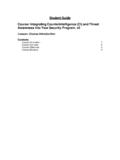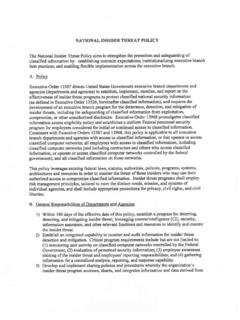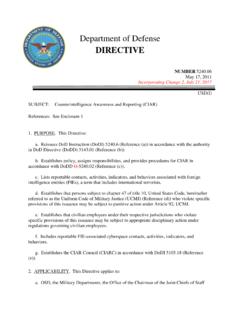Transcription of Open-Source Intelligence ATP 2-22
1 ATP Open-Source Intelligence July 2012. DISTRIBUTION RESTRICTION: Unlimited Distribution Headquarters, Department of the Army *ATP Army Techniques Publication Headquarters No. (FMI ) Department of the Army Washington, DC, 10 July 2012. Open-Source Intelligence Contents Page INTRODUCTION .. v Chapter 1 Open-Source Intelligence (OSINT) FUNDAMENTALS .. 1-1. Definition and Terms .. 1-1. Characteristics .. 1-1. The Intelligence Warfighting Function .. 1-2. The Intelligence Process .. 1-3. The Planning Requirements and Assessing Collection Process .. 1-4. The military Decisionmaking Process .. 1-4. Intelligence Preparation of the Battlefield .. 1-5. Chapter 2 PLANNING AND PREPARATION OF THE OSINT MISSION.
2 2-1. Section I Planning OSINT Activities .. 2-1. Define the Operational Environment .. 2-1. Describe Environmental Effects on Operations .. 2-2. Evaluate the Threat .. 2-2. Determine Threat Courses of Action .. 2-2. Section II Preparation of OSINT Activities .. 2-2. OSINT Exploitation .. 2-3. Preparation Considerations .. 2-4. Section III Planning and Preparation Considerations .. 2-7. Open-Source Reliability .. 2-7. Open-Source Information Content 2-8. Compliance .. 2-8. DISTRIBUTION RESTRICTION: Unlimited Distribution . *This publication supersedes FMI , 5 December 2006. i Contents Operations 2-8. Classification .. 2-9. Coordination .. 2-9. Deception and Bias .. 2-9. Copyright and Intellectual Property.
3 2-9. Linguist Requirements .. 2-10. Machine Foreign Language Translation Systems .. 2-11. Section IV Manning the OSINT Section .. 2-13. OSINT Section Duties .. 2-13. OSINT Section at the Brigade Combat Team Level .. 2-13. Task Organization Considerations .. 2-15. Chapter 3 COLLECTING OSINT .. 3-1. Collecting Publicly Available Information .. 3-1. Research .. 3-3. Chapter 4 PRODUCING OSINT .. 4-1. Categories of Intelligence Products .. 4-1. Evaluate Information .. 4-2. Process Information .. 4-5. Report and Disseminate Information .. 4-10. Reporting and Dissemination Considerations .. 4-12. Appendix A LEGAL RESTRICTIONS AND REGULATORY LIMITATIONS .. A-1. Appendix B CYBERSPACE INTERNET AWARENESS.
4 B-1. Appendix C BASIC AND ADVANCED INTERNET SEARCH TECHNIQUES .. C-1. Appendix D OSINT CONTRIBUTIONS .. D-1. Appendix E OSINT ORGANIZATIONS .. E-4. Appendix F Open-Source RESOURCES .. 1. GLOSSARY .. Glossary-1. References-1. INDEX .. Index-1. Figures Figure 1-1. The Intelligence process .. 1-3. Figure 2-1. Brigade combat team's OSINT section .. 2-14. Figure 3-1. Process for collecting publicly available information .. 3-2. Contents Tables Table 2-1. Open-Source reliability ratings .. 2-8. Table 2-2. Open-Source content credibility ratings .. 2-8. Table 3-1. Open-Source media, components, and elements .. 3-5. Table 4-1. Categories of Intelligence products .. 4-1. Table 4-2. Comparison of communication types.
5 4-3. Table 4-3. Level, factors, and elements of media control .. 4-7. Table 4-4. Hierarchy of media power .. 4-8. Table C-1. Boolean logic operators, connectors, and C-3. Table C-2. Truncating and shortening uniform resource locators .. C-6. Table E-1. open Source Academy curriculum ..E-5. Table F-1. military Open-Source training and resources .. 1. 10 July 2012 ATP iii Preface ATP establishes a common understanding, foundational concepts, and methods of use for Army open - source Intelligence (OSINT). ATP highlights the characterization of OSINT as an Intelligence discipline, its interrelationship with other Intelligence disciplines, and its applicability to unified land operations. This Army techniques publication.
6 Provides fundamental principles and terminology for Army units that conduct OSINT exploitation. Discusses tactics, techniques, and procedures (TTP) for Army units that conduct OSINT exploitation. Provides a catalyst for renewing and emphasizing Army awareness of the value of publicly available information and open sources. Establishes a common understanding of OSINT. Develops systematic approaches to plan, prepare, collect, and produce Intelligence from publicly available information from open sources. The target audience for this Army techniques publication is Army units at the division level and below conducting OSINT exploitation. Defined terms are identified in the text. Definitions for which this publication is the proponent are printed in boldface.
7 These terms and their definitions will be incorporated into the next revision of FM 1-02. For other definitions in the text, the term is italicized, and the number of the proponent publication follows the definition. Terms for which this publication is the proponent are indicated with an asterisk in the glossary. OSINT personnel applies to Intelligence and nonintelligence Active Army, Army National Guard/Army National Guard of the United States, and Army Reserve personnel who engage in missions involving publicly available information and open sources. AR 381-10 defines a person as . A citizen. A permanent resident alien. An unincorporated association substantially composed of citizens or permanent resident aliens.
8 A corporation or subsidiary incorporated in the United States that is not directed or controlled by a foreign government. The following are presumed to be persons: A person or organization outside of the United States. A person not a citizen or permanent resident alien of the United States. The use or mention of the name of any commercial or private organization or its associated trademark or services by the Army does not express or imply an endorsement of the sponsor or its products and services by the Army. This publication applies to the Active Army, the Army National Guard/Army National Guard of the United States, and the Army Reserve unless otherwise stated. Headquarters, Army Training and Doctrine Command, is the proponent for this publication.
9 The preparing agency is the Army Intelligence Center of Excellence (USAICoE), Fort Huachuca, AZ. Send written comments and recommendations on DA Form 2028 (Recommended Changes to Publications and Blank Forms). directly to: Commander, USAICoE, ATTN: ATZS-CDI-D (ATP ), 550 Cibeque Street, Fort Huachuca, AZ 85613-7017. iv ATP 10 July 2012. Introduction Since before the advent of the satellite and other advanced technological means of gathering information, military professionals have planned, prepared, collected, and produced Intelligence from publicly available information and open sources to gain knowledge and understanding of foreign lands, peoples, potential threats, and armies. open sources possess much of the information needed to understand the physical and human factors of the operational environment of unified land operations.
10 Physical and human factors of a given operational environment can be addressed utilizing publicly available information to satisfy information and Intelligence requirements and provide increased situational awareness interrelated with the application of technical or classified resources. The world is being reinvented by open sources. Publicly available information can be used by a variety of individuals to expand a broad spectrum of objectives. The significance and relevance of Open-Source Intelligence (OSINT) serve as an economy of force, provide an additional leverage capability, and cue technical or classified assets to refine and validate both information and Intelligence . As an Intelligence discipline, OSINT is judged by its contribution to the Intelligence warfighting function in support of other warfighting functions and unified land operations.













